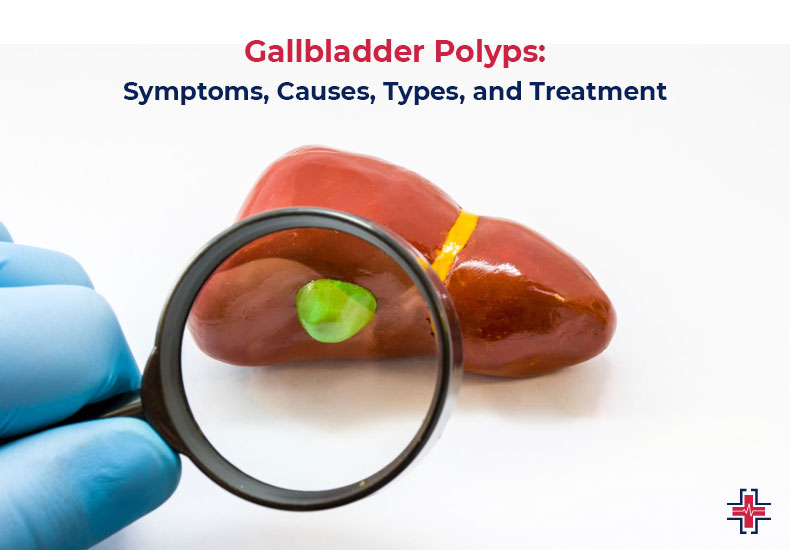The majority of gallbladder polyp sufferers do not exhibit any symptoms. A CT scan or ultrasound usually uncovers the polyps by accident.
While a small percentage of gallbladder polyps may progress to cancer, the majority do not. Symptomless polyps with a diameter of less than one centimeter (cm) do not require treatment.
This article discusses the symptoms and possible complications of gallbladder polyps. It also examines the available treatments and describes the connection between gallbladder polyps and cancer.
What Are Gallbladder Polyps?
A gallbladder polyp is a tiny, atypical tissue growth that emerges from the gallbladder’s interior lining on a stalk. They are not that uncommon.
Bile is transported from the liver to the small intestine by the gallbladder, a tiny organ. Ninety-five percent of gallbladder polyps are benign, or noncancerous, however, they might be malignant, or cancerous.
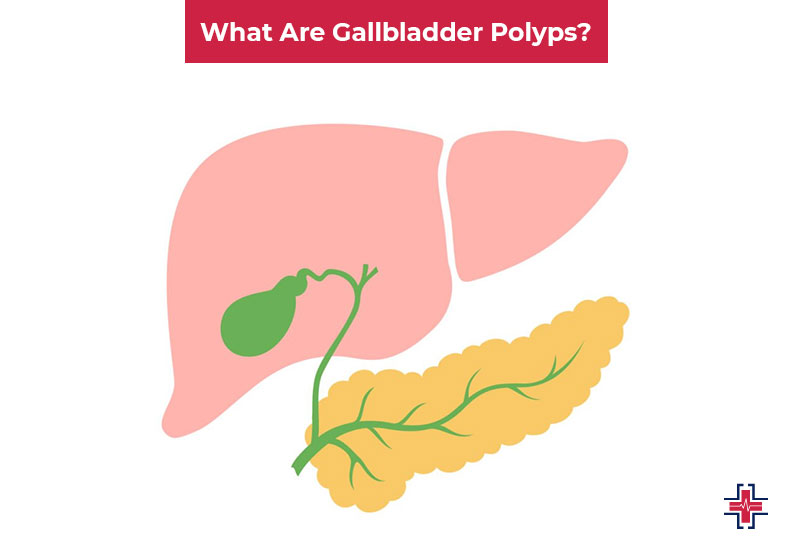
The size of a gallbladder polyp frequently indicates the existence of cancer:
- Small gallbladder polyps are usually benign, less than 1/2 inch in diameter, and don’t require treatment.
- Polyps in the gallbladder with a diameter larger than 1/2 inch are more likely to be malignant or develop into one.
- Polyps in the gallbladder greater than 3/4 inch are most likely to be cancerous.
How Common Are Gallbladder Polyps?
According to studies, gallbladder polyps may occur in 4% to 7% of adults. However, just 5 percent of them are the kind that might develop into cancer. Pseudopolyps, which are deposits of cholesterol that adhere to the gallbladder wall instead of actual tumors or “growths,” comprise between 60% and 90% of cases. Inflammatory polyps, a type of scar tissue from persistent inflammation, make up an additional 5% to 10%.
Gallbladder Polyps: What Types Are There?
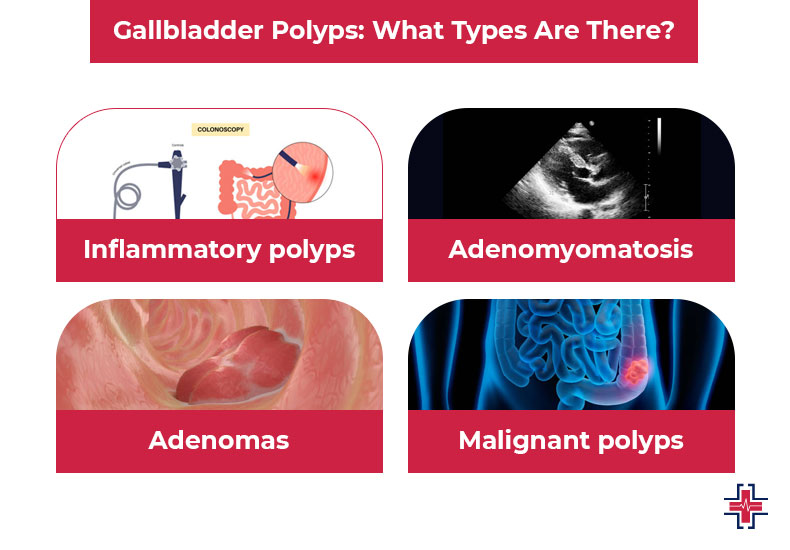
- Pseudopolyps: Also referred to as cholesterol polyps, these are the outcome of cholesterolosis, a benign disorder. It indicates that you have excess lipids related to cholesterol that build up and adhere to the gallbladder wall, resulting in polyps.
- Inflammatory polyps: A form of scar tissue connected to persistent gallbladder wall inflammation (cholecystitis).
- Adenomyomatosis: An unusual proliferation of the lining of the gallbladder resulting in gallbladder wall cysts. Although scientists are unsure of its cause, it is not dangerous.
- Malignant polyps: Typically, these are adenocarcinomas, which are the most prevalent internal organ cancers.
- Adenomas: Noncancerous growths consisting of cells resembling the biliary tract lining, which links the gallbladder to other organs. There is a.5% chance that they will develop cancer.
Symptoms of Gallbladder Polyps
Gallbladder polyps usually do not cause any symptoms. Usually, medical professionals find them by accident when they are searching for something else. A tiny percentage, nevertheless, can result in symptoms if they happen to clog the bile or cystic ducts, two channels that branch off from the gallbladder.
Cystic duct polyps have the potential to block the passage of bile into the gallbladder, leading to gallbladder wall inflammation (cholecystitis). Broken pieces that end up in the bile duct can impede the passage of bile from the gallbladder, leading to pancreatitis or cholangitis, inflammation of the bile duct.
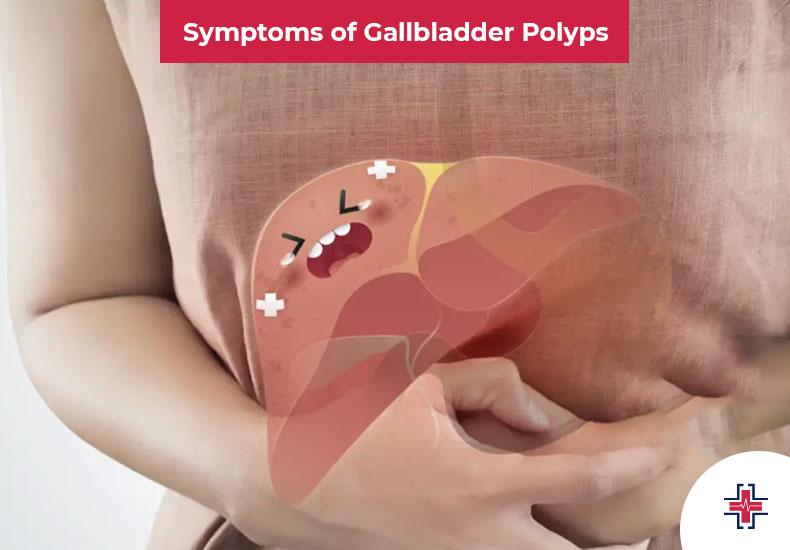
Inflammatory symptoms can include:
- Stomach ache.
- High temperature.
- Vomiting as well as nausea.
- Having a yellowish hue.
Rarely, gallbladder cancer may also be indicated by these symptoms.
What Causes Gallbladder Polyps
A true tumor is an aberrant cell proliferation. We’re not sure why they happen. Inflammatory and cholesterol polyps are not actual growths; rather, they are the result of other disorders. Cholecystitis causes inflammatory polyps, whereas cholesterolosis causes cholesterol polyps. The bulk of gallbladder polyps are of these two categories.
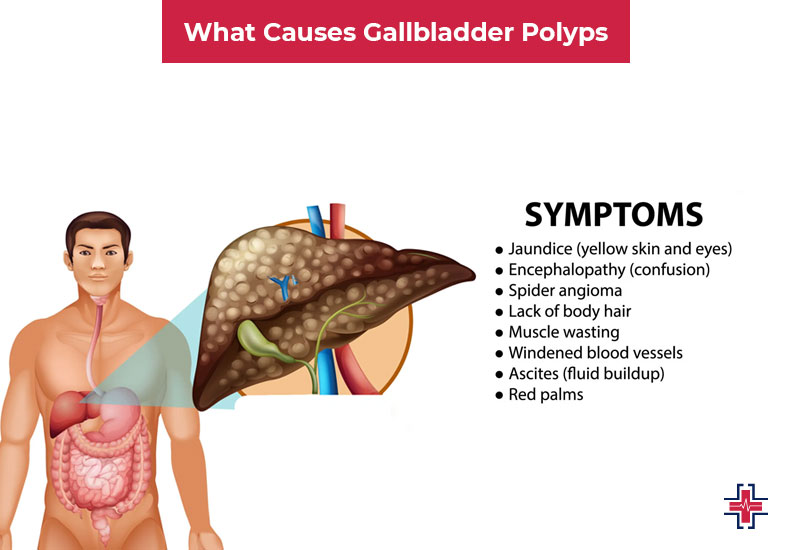
How Are Gallbladder Polyps Diagnosed?
Frequently, gallbladder polyps are unintentionally found during radiological exams like transabdominal ultrasounds. Your initial course of treatment for gallbladder problems will almost certainly involve an ultrasound. In this method, gallbladder polyps can be identified, but the type may remain unknown to medical professionals. To obtain a better look, they might want to follow up with a more thorough imaging test, like a CT scan or an endoscopic ultrasound.
Gallbladder Polyps Treatment
The size of the growth affects the treatment of gallbladder polyps.
If the width of your polyps is less than half an inch, your doctor may recommend routine ultrasound examinations to check for any changes that could point to cancer. Your physician might suggest endoscopic or abdominal ultrasounds.

If the diameter of the polyps is more than 1/2 inch, your doctor may suggest surgically removing the gallbladder. The name of this procedure is cholecystectomy. This course of treatment is advised by many specialists if you have gallbladder polyps in addition to gallstones.
Observation
Most polyps won’t harm you or need to be treated, but your doctor will want to monitor them to make sure they aren’t developing too quickly or becoming too large, or if they are causing any new symptoms. To do this, they’ll perform routine ultrasonography exams. Their recommendation will be to remove the gallbladder if they notice any concerning tendencies.
Surgery
The only recognized treatment for gallbladder problems, despite the fact that it may seem severe, is gallbladder ectomy. Your doctor will advise removal if your polyps cause inflammation or gallstones in order to stop further problems. Additionally, they will advise it for any potential risk of malignancy. You don’t need your gallbladder to survive.
Surgery to remove the gallbladder comes in two varieties.
- A few tiny incisions are made during a laparoscopic cholecystectomy, a minimally invasive procedure that allows the surgeon to remove your gallbladder. Rather than making an incision in your abdomen, the surgeon uses a tiny, illuminated camera called a laparoscope to find your gallbladder on a screen. The gallbladder is then removed via a second, tiny incision. When feasible, surgeons want to employ the laparoscopic approach since it results in fewer problems and requires a shorter recovery period (approximately two weeks).
- When there is a high suspicion of malignancy, an open cholecystectomy may be necessary. This is due to the possibility that the surgeon will need to remove lymph nodes and other impacted structures in addition to the gallbladder. To access your abdomen during an open cholecystectomy, a single, bigger incision must be made behind your right rib cage. With a lengthier recuperation period (about six to eight weeks), this surgery is more involved.
Gallbladder Polyps Are Associated With What Risk Factors?
There are always dangers associated with surgery, such as bleeding, anesthesia-related problems, and harm to surrounding organs. These are not as dangerous as the chances of developing cancer. The removal of your gallbladder has no long-term negative repercussions.
You may be more likely to develop gallbladder polyps if you have:
- Gallstones.
- Cholecystitis.
- Cholangitis.
- Hepatitis B.
- Familial Adenomatous Polyposis (FAP).
- Peutz-Jeghers Syndrome.
- High cholesterol.
- You’re over age 50.
How Fast Do Gallbladder Polyps Grow?
Usually, a single polyp grows little more than 2 millimeters in a year. A cancerous polyp could expand more quickly. At your yearly visit, if your doctor notices rapid growth, they can advise having the polyp removed.
Malignant polyps typically occur in singles, but benign polyps are more likely to occur in groups. Your polyps are probably not cancerous if they proliferate quickly. However, they could also be a sign of another illness, like persistent cholecystitis.
How Will I Recover From Gallbladder Removal Surgery?
After having their gallbladder removed, the majority of patients heal well and their problems don’t come back. Your gallbladder is no longer necessary for the proper operation of your digestive tract. Without first being stored in the gallbladder, your liver will immediately transfer bile into your small intestine. After surgery, you might need to restrict your fat intake at first, but most people can resume their regular diet after a few weeks.
What Percentage of Gallbladder Polyps Are Cancerous?
The percentage of malignant gallbladder polyps is only 5%. If you have gallstones with a gallbladder polyp of any size, or if the polyp is larger than 1/3 inch (about 8 mm), a cholecystectomy may be advised. A cholecystectomy might also be advised if you suffer from primary sclerosing cholangitis.
sadly, without removing the polyps, medical professionals are unable to determine with certainty whether they are malignant. Additionally, removing the gallbladder completely is necessary to eliminate the polyps. Even while you can survive without a gallbladder, medical professionals prefer not to remove one without a valid reason. They attempt to determine the probability of cancer by utilizing your symptoms and associated risk variables.
Typically measuring more than two centimeters in diameter, malignant polyps are typically larger than benign ones. Healthcare professionals usually advise removing a polyp that is one centimeter or larger just to be safe. Additionally, they will advise treating any inflammation-related symptoms including pain and fever. They’ll keep an eye on the remaining polyps on you with yearly ultrasounds.
What Size Gallbladder Polyps Should Be Removed?
Any polyp felt to be symptomatic in the gallbladder should be removed. A polyp of six millimeters or more should probably be removed from people who are at risk of cancer. For additional assessment, patients without risk factors make excellent candidates for EUS.
Final Thoughts
The majority of gallbladder polyps are not cause for concern, though they can take many different forms. Although polyps may indicate the presence of another problem, they are most likely not the source of your symptoms if they unexpectedly appear on an ultrasound. Even though there is only a.5% risk that a polyp can become cancerous, your doctor at the ER of Mesquite – Emergency Room may advise removal if they find one. You’ll be alright without your gallbladder if that occurs. Although the majority of polyps removed in this manner out to be benign, it’s better to be cautious.
